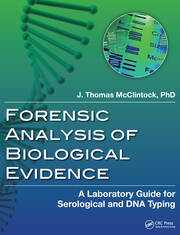1st Edition
Forensic Analysis of Biological Evidence A Laboratory Guide for Serological and DNA Typing
A powerful tool in the identification of individuals, DNA typing has revolutionized criminal and paternity investigations. Widespread analysis is now conducted by public and private laboratories in the United States and abroad. Focusing on the basic techniques used in forensic DNA laboratories, Forensic Analysis of Biological Evidence: A Laboratory Guide for Serological and DNA Typing introduces readers to the science of serological analysis and DNA typing methods and provides a thorough background of the molecular techniques used to determine an individual’s identity or parental lineage.
Originally published as Forensic DNA Analysis: A Laboratory Manual, this revised work offers updated exercises and protocols for all kinds of DNA and serological analyses with delineated objectives, step-by-step procedures, and required laboratory supplies. Each exercise in this manual:
- Provides an overview of forensic DNA analysis
- Explains the sources or types of biological material used in a particular DNA analysis
- Supplies the background principles and practical methodology for specific serological analysis and DNA typing techniques
- Simulates human forensic testing and can also be used to simulate a wide range of applications for genetic analysis
The book contains an extensive glossary to make readers familiar with terminology used in the forensic analysis of biological evidence, as well as basic terms used in molecular biology. Those who master the material in this volume will understand the methodology of the investigation in DNA typing, develop an understanding of the scientific principles involved in serology and DNA analysis, and succeed in analyzing and interpreting the data generated in each exercise with clarity and confidence.
An Overview of Forensic DNA Analysis
Types of Biological Specimens
Exercise 1: Evidence Examination Using an Alternate Light Source
Forensic Serology
Exercise 2: Detection of Saliva
Exercise 3: Detection of Blood
Exercise 4: Detection and Identification of Semen
Exercise 5: Detection and Identification of Urine
Exercise 6 - DNA Extraction
Exercise 7: Concentration of Extracted DNA
Exercise 8: Microcon Concentration and Purification of Extracted DNA
Exercise 9 - Assessing the Quality and Quantity of Isolated DNA
The Polymerase Chain Reaction (PCR)
Exercise 10: Short Tandem Repeat (STR) Analysis
Exercise 11: Using Short Tandem Repeat (STR) Analysis to Determine Paternity (A Case Study)
Exercise 12: Polymerase Chain Reaction (PCR)-Based Tests: Y-Chromosome Short Tandem Repeat (Y-STR) Analysis (A Case Study)
Exercise 13: Mitochondrial DNA (mtDNA) Analysis
Exercise 14: Assessment of DNA Typing Data
Single Nucleotide Polymorphisms (SNPs) for Human Identification: An Emerging Forensic Tool
References and Suggested Readings
Appendix A: Composition of Buffers and Solutions
Appendix B: Using a Micropipet
Appendix C: Glossary
Index
Biography
J. Thomas McClintock




